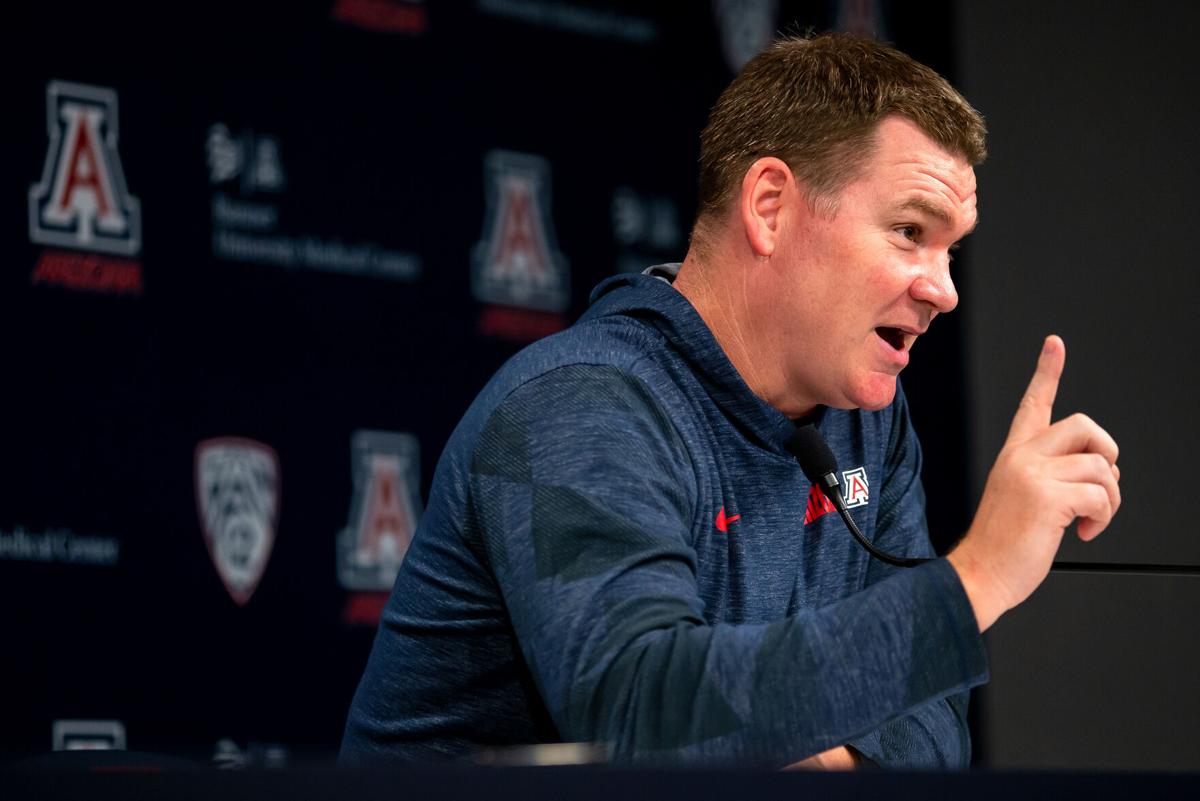Tommy Lloyd’s first list of opponents at Arizona can be separated into three categories:
Seven walkover victories. The UA’s non-conference home schedule is tissue-type soft, possibly the most unappealing group of well-paid victims (each visiting team gets close to $90,000 to play at McKale Center) since 1966-67. Yes, 1966-67.
Four difficult out-of-state games. The Wildcats will face Top-25 powers Illinois, Tennessee and most likely Michigan in the finals of a made-for-TV doubleheader in Las Vegas. There’s also a game in Vegas against Wichita State.
Twenty taxing Pac-12 games. It’s not that the soft-for-a-decade basketball conference has suddenly matched the ACC or Big Ten in degree of difficulty. But except for Cal, the other nine Arizona road stops look to be no better than 50/50 games. The only legitimate chance for a Pac-12 road sweep is at Stanford and Cal. If Lloyd’s first Arizona team can go 4-6 on the Pac-12 road, consider it a success. The Pac-12 schedule-maker gave Arizona a break because the Wildcats don’t have to play at Oregon.
Even though it has been 38 years, Lloyd’s first season at Arizona has a compelling link to Lute Olson’s first Arizona season, 1983-84.
It is well-documented that Olson inherited a situation no better than what Arizona football coach Jedd Fisch was handed this season. The ’83-84 Wildcats opened 3-11, which included an 0-4 stumble in Pac-10 games.
Lloyd’s Wildcats should do better than that 0-4 conference start, but how much better? They play Washington and at Oregon State in early December, and then start the rest of the league schedule at UCLA and USC. If they win more than one of those games, it’ll be somewhat promising.
A trip to Arizona State follows that, and then UA returns to Tucson to play Colorado in Game 6, but that is no walkover, either.
Beyond that, the link that ties Lloyd to Olson is that Arizona added Texas-Rio Grande Valley to the home schedule, Nov. 12.
Olson’s third-ever home game was also against Texas-Rio Grande Valley (then known as Pan American University). But the core of a roster Olson inherited from a 4-24 team did not include a Bennedict Mathurin or a Azuolas Tubelis, possible first-team all-conference players.
Looking back, it seems impossible that UTRGV ever won a game at McKale Center, but on Dec.10, 1983, the Vaqueros beat Arizona 65-60. Steve Kerr scored two points. The small crowd (6,087) could not possibly have imagined that over the next 25 years of UA basketball would be played at an elite level with four Final Four appearances.
UTRGV has not played Arizona since that unmemorable day in 1983. And it’s not like the Vaqueros are likely be prepared for the environment and talent they’ll see at McKale Center on Nov. 12. Before playing in Tucson, UTRGV will play Texas A&M International. After they return to Edinburg, they’ll play Paul Quinn College.
Yes, Paul Quinn College.
The immediate and most significant challenge for Lloyd will be to reestablish McKale Center as the most dreaded home venue in the Pac-12. If Arizona can go 8-1 in conference home games and win the seven nonconference softies, that 15-1 pad could enable Arizona to finish third or fourth in the Pac-12 and fit easily into season-long NCAA Tournament bracketology projections.
But winning at McKale Center, taken for granted from 1985-2018, eroded during the troubled finish to the Sean Miller period.
Over the last three years, Arizona went 37-14 at McKale Center. That’s 73%. That’s unacceptable in Tucson.
In the previous history at McKale, 1972-2018, the Wildcats won 85% of their home games. They never lost more than eight games in a three-season period.
Thus, making McKale Center the most feared venue in Pac-12 basketball is Lloyd’s first charge.
Lloyd knows success. In his last five years at Mark Few’s lead assistant at Gonzaga, the Zags went 164-14. That’s a 92% success rate. And although that was inflated by playing in the lower-tier West Coast Conference against Loyola Marymount, Pacific and Portland, Lloyd is imbued by an expectation to win big.
That’s what he brings to Tucson. High expectations.
Winning in your first year as a Pac-12 head coach has been an overwhelming challenge for the 10 men I consider the top coaches hired by conference schools the last 40 years. Only two of those 10, UCLA’s Jim Harrick and Colorado’s Tad Boyle (who had already been the Buffaloes’ coach for a year when they joined the league), reached the NCAA Tournament in Year 1 in the Pac-12. That’s crazy. Here’s how it went in the first season for those 10 accomplished coaches, in order of their arrival:
Lute Olson, Arizona: 11-17 (8-10 in Pac-10) in 1983-84
George Raveling, USC: 9-19 (4-14 in Pac-10) in 1986-87
Mike Montgomery, Stanford: 15-13 (9-9 in Pac-10) in 1986-87
Jim Harrick, UCLA: 21-10 (13-5 in Pac-10) in 1988-89
Bill Frieder, ASU: 15-16 (6-12 in Pac-10) in 1989-90
Lorenzo Romar, Washington: 10-17 (5-13 in Pac-10) in 2002-03
Ben Howland, UCLA: 11-17 (7-11 in Pac-10) in 2003-04
Sean Miller, Arizona: 16-15 (10-8 in Pac-10) in 2009-10
Dana Altman, Oregon: 21-18 (7-11 in Pac-12) in 2010-11
Tad Boyle, Colorado: 24-12 (11-7 in Pac-12) in 2011-12
Even though they reached the NCAA Tournament, Harrick’s Bruins paid their dues that first season, much like Lloyd’s Wildcats could when they play at heavily-favored and preseason No. 2 UCLA at Pauley Pavilion on Dec. 30.
In Harrick’s first trip to McKale Center, 1989, the Bruins lost 102-64.
No one said this is going to be easy.





